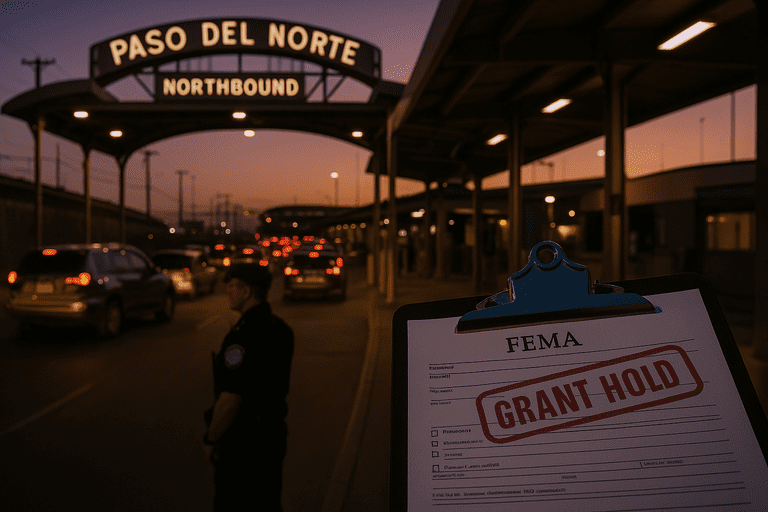🎧 Listen to the summary:
The Trump administration’s decision to align disaster aid with immigration enforcement promises a clearer, tougher front against the smuggling networks that profit from unlawful crossings, while restoring confidence that federal dollars serve border security and public safety first. The policy directs agencies to halt grants that indirectly support unauthorized migration and to re‑tool cooperation so funds reinforce enforcement priorities.
The core directive arrived by executive order on February 6, instructing departments to stop funding nongovernmental organizations deemed to “undermine the national interest.” FEMA launched a wholesale review of 56 programs and temporarily froze nearly $10 billion for nonprofits, including money to rebuild facilities after disasters and to provide short-term housing for survivors. Almost all FEMA disaster programs were later found to comply with the order, but two remained under review: roughly $8.5 billion for nonprofit rebuilding and $1.3 billion for nonprofit short‑term housing.
Implementation moved through agency memos and DHS oversight. Acting FEMA Administrator Cameron Hamilton issued the grant review directives on March 20. DHS Secretary Kristi Noem approved them the following week, the same day she publicly discussed eliminating FEMA, a statement that officials later said was unrelated to the review. FEMA also flagged two state emergency management programs, together allocating about $800 million a year, as at “high likelihood” of providing funds to immigration‑related nonprofits; those programs were frozen pending a DHS review.
The effort intersects with the Shelter and Services Program, a joint initiative of FEMA and Customs and Border Protection designed to manage noncitizen families awaiting case adjudication. In New York, $59 million from that program became a flashpoint after a judge twice ordered the administration to keep money flowing. A senior FEMA official nevertheless directed staff to place holds on awards across multiple grant lines dating back years, and four FEMA employees were later dismissed. Average hotel costs for migrant families under the program were reported at $156 per night, compared with roughly $400 for standard hotel stays in New York. The White House signaled that litigation over injunctions would continue.
The policy reaches well beyond the border but lands squarely in communities that experience the consequences of cartel‑driven migration and fentanyl trafficking. Nonprofits, including hospitals and shelter providers, faced grant holds as FEMA examined whether the funding could be interpreted as aiding undocumented migrants. States and municipalities that rely on FEMA’s broader disaster and preparedness architecture received assurances that most programs would proceed, even as specific lines stayed paused for compliance checks.
Trade‑offs appeared quickly in the record. Former FEMA chief of staff Michael Coen warned that freezing nonprofit recovery funds would “adversely impact” rebuilding in places like North Carolina, Los Angeles, and West Virginia, where local NGOs are woven into disaster response. The agency’s own documents emphasized that tens of billions in state recovery money would continue, but the targeted freezes created delays for entities that had planned on federal reimbursements. These are operational consequences, not policy goals, but they emerge from the same review process.
Administrative friction also surfaced. A federal judge issued restraining orders against broad grant freezes, even as internal emails instructed program managers to hold awards across emergency preparedness, homeland security, firefighting, nonprofit security, and tribal safety lines. DHS framed dismissals of FEMA staff as accountability for unauthorized payments, while an outside advisory arm—the Department of Government Efficiency—amplified scrutiny of the agency’s New York expenditures. The facts document an expanding compliance apparatus and legal push‑and‑pull that can slow everyday grant administration.
The White House characterized the review as part of a broader border crackdown, while outside proposals signaled shifting political ground. Some Democrats highlighted plans that increase Border Patrol staffing, tighten asylum processing, and invest in stopping dangerous drugs—an area that intersects with the administration’s emphasis on curbing indirect incentives for unlawful crossings. These parallel tracks suggest a narrowing space between enforcement priorities across parties, even as methods and constituencies differ.
The unintended effects are visible in the paperwork. A targeted freeze designed to prevent indirect support for unlawful migration also pauses grants that rebuild nonprofit hospitals after floods and fires. A compliance sweep intended to steer dollars away from shelter networks can ripple into local disaster housing arrangements unrelated to the border. Litigation creates contradictory instructions for civil servants, and the additional reviews create new queues for applicants. The record shows that nearly all core disaster programs continued, but the carve‑outs generated uncertainty across grant calendars and vendor contracts.
The federal footprint at the border thus expands in one domain while constricting in another. FEMA’s joint work with CBP remains a designated tool for managing migration surges, even as its grants to nonprofit partners face heightened scrutiny. DHS approvals, internal memos, and judicial orders now function as parallel guardrails on implementation, reflecting an enforcement‑first posture tempered by compliance findings and court supervision.
Next steps follow the docket and the memo trail. DHS continues reviewing the nonprofit rebuilding and short‑term housing programs, with funds on hold until determinations are made. The two state emergency management grant lines remain frozen pending DHS assessment. Court injunctions require agencies to maintain funding flows where ordered, and FEMA has authorized money to states and municipalities to proceed outside the paused programs. The White House has signaled continued litigation to defend executive authority. These mechanisms—DHS reviews, agency directives, and federal court oversight—constitute the immediate guardrails on how the policy is carried out.
—
Lisa Grant reports on immigration enforcement, border operations, and national security protocols. She studied political science at Arizona State University and previously worked as a legislative staffer on immigration reform. Her reporting brings a field-level understanding of border policy and how it is applied in communities across the Southwest.



